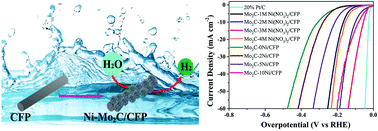Self-supported nickel-doped molybdenum carbide nanoflower clusters on carbon fiber paper for an efficient hydrogen evolution reaction†
Abstract
Developing an efficient, stable and low-cost noble-metal-free electrocatalyst for the hydrogen evolution reaction (HER) is an effective way to alleviate the energy crisis. Herein, we report a simple and facile approach to synthesize self-supported Ni-doped Mo2C via a molten salt method. By optimizing the content of Ni, the concentration of Ni(NO3)2, and the annealing time, self-supported nanoflower-like electrocatalysts composed of ultrathin nanosheets on carbon fiber paper (CFP) can be achieved. Such a fluffy and porous nanoflower-like structure has a large specific surface area, which can expose many active sites, and promote charge transfer; moreover, all of the above is beneficial for improving the HER performance. Density functional theory (DFT) calculations reveal that the doping of Ni leads to a down shift of the value of the d band center (εd), so that the adsorbed hydrogen (Hads) is easier to desorb from the catalyst surface, thus leading to an enhanced intrinsic catalytic activity of Ni doped Mo2C based catalysts. As a result, Mo2C-3 M Ni(NO3)2/CFP with a nanoflower-like structure prepared at 1000 °C for 6 h exhibits the best electrocatalytic performance for the HER in 0.5 M H2SO4, with a low overpotential of 56 mV (at j = 10 mA cm−2) and a Tafel slope (27.4 mV dec−1) comparable to that of commercial Pt/C (25.8 mV dec−1). The excellent performance surpasses most of the noble-metal-free electrocatalysts. In addition, the outstanding long-term durability of Mo2C-3 M Ni(NO3)2/CFP is demonstrated by showing no obvious fluctuations during 35 h of the HER testing. This work provides a simple and facile strategy for the preparation of nanoelectrocatalysts with high specific surface areas and high catalytic activities, both of which promote an efficient HER.

- This article is part of the themed collection: Nanoscale Horizons, Nanoscale, and ChemComm: Nanocatalysis


 Please wait while we load your content...
Please wait while we load your content...